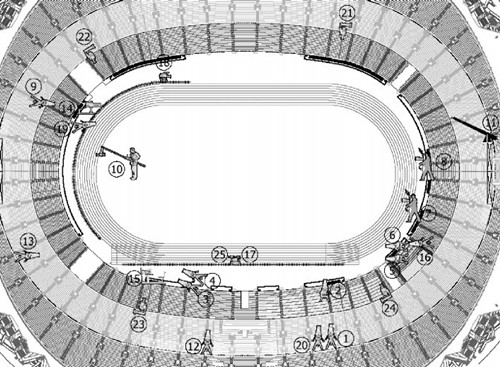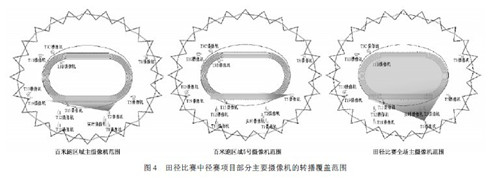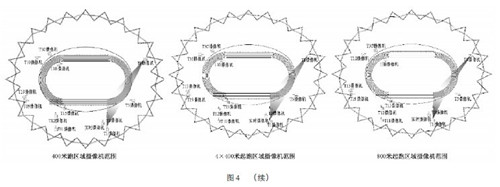1 Overview
The National Stadium (Bird's Nest) is located in the southern part of the Beijing Olympic Park's central area, on the eastern side of the northern end of Beijing's central axis. It is the main stadium of the 29th Olympic Games in 2008. The project covers a total area of ​​21 hectares and a building area of ​​258,000 square meters. There were about 91,000 seats in the audience, of which about 11,000 were temporary seats. The opening and closing ceremonies of the Beijing Olympics and Paralympics, the track and field competitions and the finals of the football match were held here. After the Olympic Games, you can undertake special major sports competitions (such as the World Athletics Championships, World Cup soccer tournaments, etc.), various regular sports events and non-sports competitions (such as cultural performances, group events, etc.), and will provide extensive participation for Beijing residents. Sports activities and large professional venues for sports and entertainment.
The National Stadium will become a new highlight of the country's iconic sports architecture and urban construction, and will become a valuable cultural heritage left by the Olympic Movement to the city.
2 National Stadium sports lighting requirements
In order to enable athletes to play the best level of competition, the audience around the world can truly and clearly understand the dynamics of the stadium, and integrate the greatest enthusiasm for watching the game, excellent stadiums are essential; and the excellent stadiums need the highest quality professional. Sports lighting. Good stadium lighting brings the best live performance and TV coverage to the athletes, referees, spectators and billions of TV viewers around the world. The role of lighting in Olympic venues has become increasingly important.
Due to the diversity of the competition and the importance of the event, the lighting design requirements of the National Stadium are extremely strict. It is necessary to give full consideration to the visual needs of athletes, referees/officials, live audiences, television viewers (cameras), media readers (cameras), etc., to provide optimal illumination for all parties. In addition to providing adequate, uniform horizontal and vertical illumination, more camera requirements and more stringent glare control should be considered.
In order to achieve the best broadcast effect, BOB (Beijing Olympic Broadcasting Committee) proposed the most stringent lighting requirements for the previous Olympic Games for the National Stadium, exceeding the lighting standards of individual sports organizations, CIE, and other related lighting agencies, as well as 2004 Athens. The lighting standards for the main venue of the Olympic Games are more specific and stricter.
2. 1 Higher illumination level requirements
As the national stadium with the highest level of Olympic Games in the world, in order to meet the needs of the event broadcast, more than 100 high-definition cameras and high-definition ultra-high-speed color cameras have been deployed as broadcast equipment, from large-scale main cameras covering the entire audience. Fixed or moving cameras in various areas, from slow motion playback cameras to tracks or automatic cameras, from panoramic (ambient) cameras to special cameras at specific locations (such as foul cameras, goal cameras, etc.), from start point cameras, end point cameras or real time From camera cameras to award-winning cameras, etc., for such a large number of cameras, lighting must meet the requirements of BOB to provide the best lighting effect to ensure the most comprehensive TV broadcast picture, and smooth switching between different cameras.
In the Olympic lighting requirements of the National Stadium, the minimum vertical illumination requirement for any fixed camera during the Olympic Games broadcast is Ev min> 1400 lx, requiring a minimum vertical illumination of more than 1000 lx for moving cameras or perpendicular to the four sides of the site; The lighting standards of the organization and CIE require that the average vertical illumination of the main camera Ev ave > 1400 lx or 2000lx during color TV broadcast, there is no special requirement for other cameras and vertical illumination perpendicular to the four sides of the site. This fully reflects the requirements of high-definition broadcast and the attention of every place and every moment in the Olympic Games.
2. 2 Lighting illumination uniformity requirements are improved
When the National Stadium Olympic Games is broadcasted on television, the horizontal illumination uniformity requirements:
The ratio of the minimum to the maximum Eh min /Eh max > 0. 6 (preferably 0. 7)
Minimum to average ratio Eh min /Eh ave > 0. 8
When the Olympic Games are broadcasted on television, the uniformity of vertical illumination for fixed cameras is required:
The ratio of the minimum to the maximum Ev min /Ev max > 0. 6 (preferably 0. 7, special area: 0. 7 /0. 9)
The ratio of the minimum to the average Ev min /Ev ave > 0. 7 (preferably 0. 8, special area: 0. 8 /0. 9)
When the Olympic Games are broadcast on television, the uniformity of vertical illumination for moving cameras or four directions is required:
The ratio of the minimum to the maximum Ev min /Ev max > 0. 4
Minimum to average ratio Ev min /Ev ave > 0. 6
These uniformity indicators are more demanding and stricter than previous sports lighting standards, especially for the main camera, while the requirements for the newly added four-sided vertical illumination are also clearer.
2. 3 requirements for illumination illumination gradient
In addition to meeting the minimum, maximum and average requirements of the whole field illumination, the illumination of the National Stadium Olympic Games more clearly proposes the numerical indicators of the illumination gradient, requiring that the illumination around any point in the site and the maximum gradient of illumination at this point should not exceed 20% (4m interval) and 10% (2m interval) to meet the uniform illumination in a small area and maximize the quality of the broadcast.
2. 4 When the illumination illumination ratio is required to increase the national stadium Olympic Games TV broadcast, the ratio of the average horizontal illumination to the average primary camera direction vertical illumination should be between 0.75 and 1.5 (preferably 1:1) to meet The overall three-dimensional feel of the venue and the comfort of the venue lighting.
The ratio of the minimum to the maximum of the four vertical illuminances perpendicular to the four sides of the site at any point in the playing field shall not be less than 0.6, to meet the vertical illuminance in all directions at any point in the field, thereby enhancing the illumination. The three-dimensional sense meets the lighting requirements of the cameras in all directions, capturing the excitement of sports competitions from all directions.
2. 5 Requirements for the lighting source of the Olympic Games venue
The HD camera can adjust the white balance according to the color temperature of the scene lighting scene to reproduce the white color consistent with the daylight color illumination, but this adjustment is very difficult and cumbersome, and the adjustment between different cameras and different cameramen cannot be consistent. At the same time, the color deviation between different light sources will make this adjustment more difficult. In addition, even a light source of the same color temperature will have a different color rendering index due to its different spectra. A light source with a daylight color but a CRI of only 70 may display red and pink as a tarnish-like brownish gray, which will cause the camera. In the broadcasted picture, the athlete's skin color loses its healthy color. If the eyes of the person at the game site can be properly compensated according to experience, the camera lens cannot make similar compensation. Therefore, BOB requires the rated color temperature of the light source Tc = 5600K, the color temperature deviation of the light source does not exceed the tolerance range of IEC, and the color rendering index (CRI Ra8) ≥ 90. It is also required that the light source be the same manufacturer and the same batch of products to minimize the influence on the on-site lighting effect and the quality of the TV broadcast picture due to the inconsistency of the color difference or color drift of the illumination source.
2. 6 auditorium lighting
In order to ensure the atmosphere of the audience and the overall effect of the TV broadcast screen, the average illumination of the main camera for the first 15 rows of auditors is required to be no less than 10% of the average vertical illumination Ev-ave of the competition venue, and no higher than 25 of the average illumination. %, the audience illuminance after 15 rows should be reduced according to the uniform ratio.
2. 7 Lighting requirements for glare restrictions
In order to further improve the lighting comfort of the venue and improve the quality of the broadcast, the National Stadium requires that the glare index GR of all fixed cameras should not exceed 40 during the Olympic Games, and the glare index GR of the observers in the venue must not exceed 50. The luminaires must not be projected directly onto the fixed camera. Different movements require different luminaires to project the maximum elevation angle to reduce glare. BOB requires that the maximum projection angle of the luminaire not exceed 68°.
In addition to controlling direct glare, it is also necessary to control the reflected glare caused by the reflection of the material of the site, especially for the main camera to control the reflection bright spots in the imaging range, and improve the quality of the broadcast picture.
3 Regional changes in Olympic sports lighting at the National Stadium
Due to the improvement of the level of competition and the fierce competition, it is often found that the competition is not only within the line of the venue, so the national stadium lighting requirements are larger. The FOP of the track and field competition area requires 1 meter for the site marking area. The range of the 100-meter straight track in the track and field competition ranges from 10 meters before the start point to 30 meters after the finish line; the illumination range for the 110-meter straight line is from 5 meters before the start point to 30 meters after the finish line.
In order to make the most exciting part of the competition can be fully recorded and viewed, BOB put forward the concept of special lighting area (relay playback area) in the FOP of the National Stadium competition project, such as the 100 meters straight track from the starting point. a special area 30 meters behind the finish line; a special area from the front 5 meters from the starting point to 30 meters after the finish line; 100 meters starting area, 110 meter hurdle starting area, 200 meters starting area, 400 meters / 4 X100 meters starting area, 800 meters starting area; finish line; obstacle pool, etc., Tiansai's high jump / pole vault running area, crossing area, mat landing area; long jump / triple jump run area, bunker landing Zone; the run-up area of ​​the javelin; the throwing area of ​​the discus, the hammer, the shot; the springboard/throwing line (foul line), etc., the minimum illumination requirements of these areas are the same, but the uniformity of the contrast and the illumination gradient are more demanding than the whole higher. And sometimes the minimum vertical illumination requirement for the relevant camera in this area is greater than the average vertical illumination of the main camera of the whole field.
In addition to the competition area, the lighting of the National Stadium shall provide BOB-compliant lighting design for marathon passages, outdoor training grounds, indoor training grounds, mixed areas, press conference halls, podiums, flag-raising areas, Wan national flag and outdoor integrated areas. To ensure the smooth running of the Olympic Games.
4 National Stadium sports lighting relay camera consideration
Since the National Stadium needs to hold football finals and all track and field events during the Olympics, BOB has set up more than 100 cameras for high-definition broadcasts to broadcast the world to the world. Therefore, in order to meet the lighting of all the cameras in the lighting design, The requirement is that you first need to know the location of all the relay cameras, and also need to understand the functions of these cameras and the areas covered by the relay to fully meet the lighting requirements of different cameras.
The National Stadium's sports lighting design plan considered the lighting requirements of 93 cameras (15: football, track and field: 74, full: 4) and mobile cameras (four-sided vertical illumination) to meet the requirements of different competitions. There are multiple cameras in the same area for photographic tracking, especially for the multi-camera tracking of the runway, starting point and finish line of major events such as 100 meters and 110 meters, and the wonderful pictures of the game are broadcasted from all directions.
Figure 1 shows the main camera positions for a football match.
Figure 2 shows the coverage of the main camera of the football match.
Figure 3 shows the camera position of the track and field events in the track and field competition.
Figure 4 shows the coverage coverage of some of the main cameras in the track and field competition track project.
Figure 5 shows the camera position of some field events in the track and field competition.



Figure 3 Camera position of the track and field competition track and field event



Figure 5 Camera position of part of the field competition